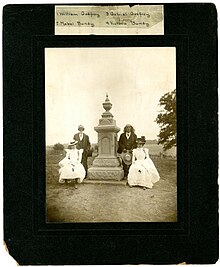Frances Slocum (Maconaquah) | |
|---|---|
 Frances Slocum (age 66), portrait by George Winter, 1839 | |
| Born | March 4, 1773 Warwick, Rhode Island, U.S. |
| Died | March 9, 1847 (aged 74) Miami County, Indiana, U.S. |
| Spouse | Shepoconah (Deaf Man) |
| Children | two sons, died at a young age two daughters, Kekenakushwa (Cut Finger) (1800–1847) and Ozahshinquah (Yellow Leaf) (ca. 1809–1877)[1][2] |
| Parent(s) | Jonathan Slocum (1733–1778) Ruth Tripp Slocum (1736–1807) |

Frances Slocum (March 4, 1773 – March 9, 1847) (Ma-con-na-quah, "Young Bear" or "Little Bear") was an adopted member of the Miami people. Slocum was born into a Quaker family that migrated from Warwick, Rhode Island, in 1777 to the Wyoming Valley in Luzerne County, Pennsylvania. On November 2, 1778, when Slocum was five years old, she was captured by three Delaware warriors at the Slocum family farm in Wilkes-Barre, Pennsylvania. Slocum was raised among the Delaware in what is now Ohio and Indiana. With her marriage to Shepoconah (Deaf Man), who later became a Miami chief, Slocum joined the Miami and took the name Maconaquah. She settled with her Miami family at Deaf Man's village along the Mississinewa River near Peru, Indiana.
In 1835 Slocum revealed to a visitor that she was a white woman who had been captured as a child, and two years later, in September 1837, three of Slocum's siblings came to see her. They confirmed that she was their sister, but Slocum chose to stay with her Miami family in Indiana. Slocum fully assimilated into the Native American culture and was accepted as one of its members. On March 3, 1845, the United States Congress passed the joint resolution that exempted Slocum and twenty-one of her Miami relatives from removal to Kansas Territory. Her Miami relations in Indiana were among the 148 individuals who formed the nucleus of the present-day Miami Nation of Indiana. She is buried at Slocum Cemetery in Wabash County, Indiana. Tributes named in her honor include Indiana's Frances Slocum Trail; the Frances Slocum State Recreation Area on the banks of the Mississinewa Lake near Peru, Indiana; Maconaquah High School in Indiana; Frances Slocum Elementary School in Marion, Indiana; Frances Slocum Elementary School, Fort Wayne Indiana;[3] and Frances Slocum State Park in Luzerne County, Pennsylvania and Mocanaqua, Pennsylvania.
- ^ Stewart Rafert (1996). The Miami Indians of Indiana: A Persistent People, 1654–1994. Indianapolis: Indiana Historical Society. p. 104. ISBN 0-87195-111-8.
- ^ Edward T. James, Janet Wilson James, and Paul S. Boyer, eds. (1971). Notable American Women 1607–1950: A Biographical Dictionary. Vol. 3. Cambridge, MA: Belknap Press. p. 298.
{{cite book}}:|author=has generic name (help)CS1 maint: multiple names: authors list (link) - ^ "Frances Slocum Elementary - Marion Community Schools". Archived from the original on 2013-02-18.